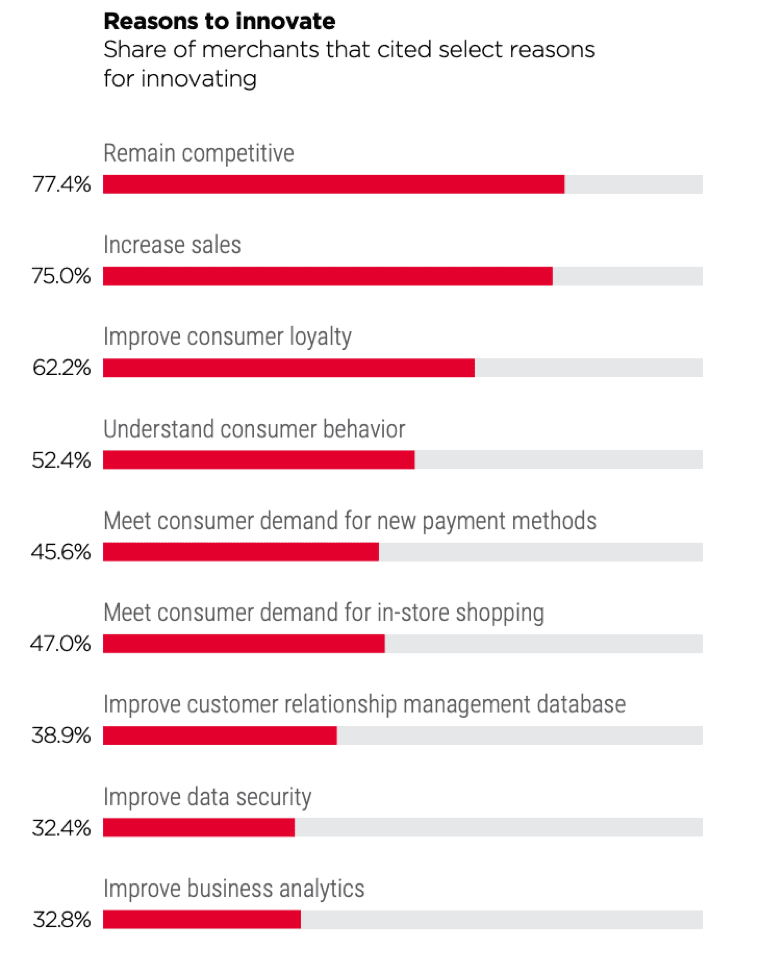What Does Innovation Mean For Small Hospitality And Food Service Businesses?

Small businesses might be optimistic about the future. In the accommodation and food services industries, they are also ready to innovate.
According to the PYMNTS Retail Innovation Readiness Index, powered by AEVI, bars, cafes, bed-and-breakfast facilities, hostels and hotels, quick-service restaurants (QSRs) and sit-down dining establishments are interested in innovations, with nearly half (48.0 percent) reporting they are “very” or “extremely” ready for innovation.
Across the board, staying competitive was the top reason accommodation and food services were innovating. Over three-fourths (77.4 percent) cited this reason, with increasing sales taking a close second at 75.0 percent.

Among smaller merchants, there was an even stronger drive to stay competitive and increase sales through innovation. The need to stay competitive was mentioned by 80.3 percent of firms earning less than $250,000 annually, while increasing sales was cited by 76.1 percent. Only half of merchants generating between $25 million and $100 million were innovating to stay competitive.
Which innovations are these merchants talking about?
For most (80 percent), it’s consumer-facing mobile apps. Hotels and hostels had the highest mobile app adoption for payment acceptance (70.4 percent) – which seems to make sense, since lodging caters to tourists who might use a variety of payment methods and currencies. Cafes and bars had the highest mobile adoption for loyalty solutions (59.1 percent), while QSRs were the biggest user of mobile for order-taking (57.4 percent).
Smart POS systems that enable electronic, cash and card transactions, and support value-added functions like the ability to provide digital receipts and perform data analytics, are also important in the world of hospitality and food service.
One in five (20.2 percent) food and accommodation merchants were already using a smart POS. Smart POS usage clocks in at 13.7 percent for smaller merchants earning under $250,000 in annual revenue. That’s a fairly high figure considering it’s only 6.5 percentage points less than the average, and nearly as high as merchants generating between $5 million and $10 million per year (14.7 percent).
There was also considerable interest among smaller merchants when they heard about possible features of a smart POS; 40.2 percent of those earning less than $250,000 per year had not heard about the technologies, but were interested in implementing them.
More than one-quarter (28.2 percent) of small businesses valued smart POS systems for their ability to be an all-in-one solution. A majority (55.6 percent) liked smart POS for the cashless payment capabilities. Cash is not dead, though; half (50.4 percent) wanted POS systems to accept cash payments. The largest merchants in this study placed nearly the same level of importance on cash acceptance.

Cash acceptance might not play an outsized role in hotel and B&B operations, but restaurants like Sweetgreen have embraced the cashless trend – not without criticism, however. In fact, the healthy fast casual chain recently started accepting cash. Meanwhile, Shake Shack decided against a move to go fully cashless, and San Francisco just became the latest city to ban cashless businesses.
When assessing smart POS systems, smaller merchants placed a higher value on customizable options (23.1 percent) and value-added services (17.9 percent) than larger merchants. Perhaps smaller merchants perceive that the ability to cater a POS system to their specific needs could be a way to get a leg up on the competition.
Plug-and-play point-of-sale (POS) solutions tend to be marketed toward smaller businesses, but in this study, smaller merchants recognize they don’t always do enough.
Smaller food and accommodation merchants are more likely to lack the resources of bigger businesses. When asked about factors that could potentially ease innovation, 23.9 percent of smaller merchants cited manager support. Larger merchants looked down the command chain and prioritized skilled employees over management buy-in.
Smaller merchants can have just as large an appetite for innovation as the big restaurants and hotels and are driven by very much the same goals, but due to limited resources, they have to be more strategic in their approach.
